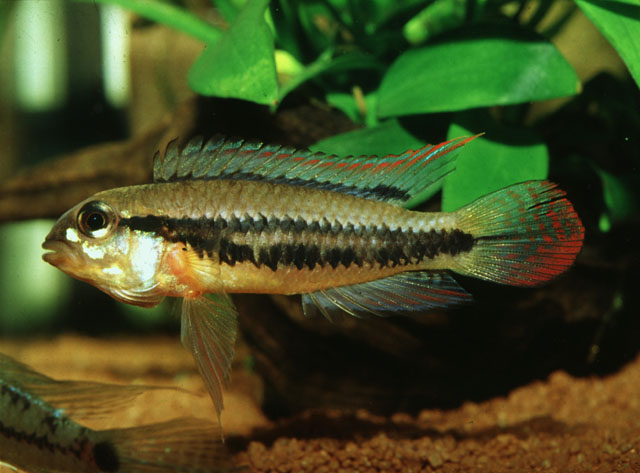| Cichlidae (Cichlids), subfamily: Geophaginae |
| 2.92 cm SL (male/unsexed); 4.5 cm TL (female) |
|
benthopelagic; freshwater; pH range: 6 - 6.5; dH range: 6 - 20 |
| South America: Amazon River basin, in the middle Negro River from San Carlos to the Arirará River. |
|
Vertebrae: 24-25. This elongate (depth 25.1-27.8% of SL), relatively small (<30 mm SL) species is distinguished by the following set of characters: presence of anguloarticular lateralis canal; four lateralis canal foramina on dentary; two infraorbital bones, second with three foramina; serrated posttemporal, supracleithrum and preoperculum; bi- or tri-serial jaw dentition; no scales on anterior chest region; males with low dorsal fin, caudal fin elongately rounded, soft dorsal, anal and pelvic fins with prolonged tips; a unique colour pattern with two horizontal bands on side, converging posteriorly and anteriorly, a ventrally widened suborbital stripe continued across branchiostegal membrane and 3 spots associated with pectoral fin base (2 on medial side of axilla, 1 on lateral side on bases of rays) (Ref. 86447). |
| Eggs are deposited on the ceiling of caves and are tendered by the female parent (Ref. 47893). Attains a maximum length 2.92 cm SL (Ref. 98797). |
|
Not Evaluated (N.E.) Ref. (130435)
|
| harmless |
|
Type locality, est. Amazonas, R., Negro drainage system, , downstream of the
R. Daraã, MZUSP 28213 (holotype of Apistogramma diplotaenia, 2.84 cm SL, male) (Ref. 86447). Known from the Amazon River basin, in the middle Negro River (Ref. 36377). Found throughout the Anavilhanas Archipelago in the Rio Negro where fishing is now forbidden (Ref. 12251). |
Source and more info: www.fishbase.org. For personal, classroom, and other internal use only. Not for publication.

